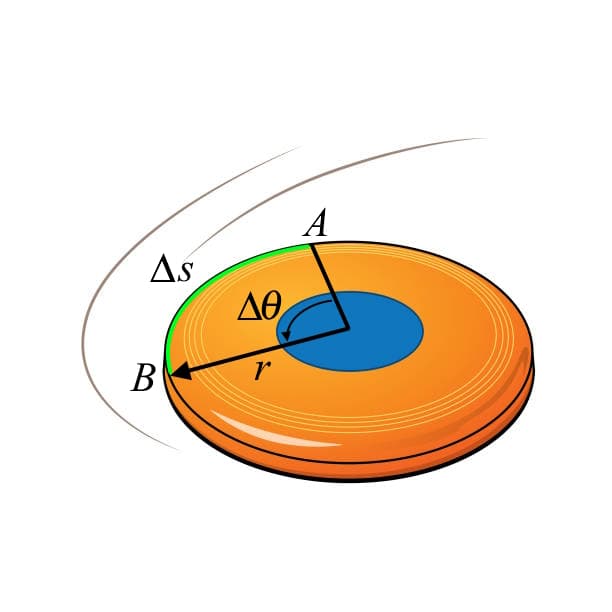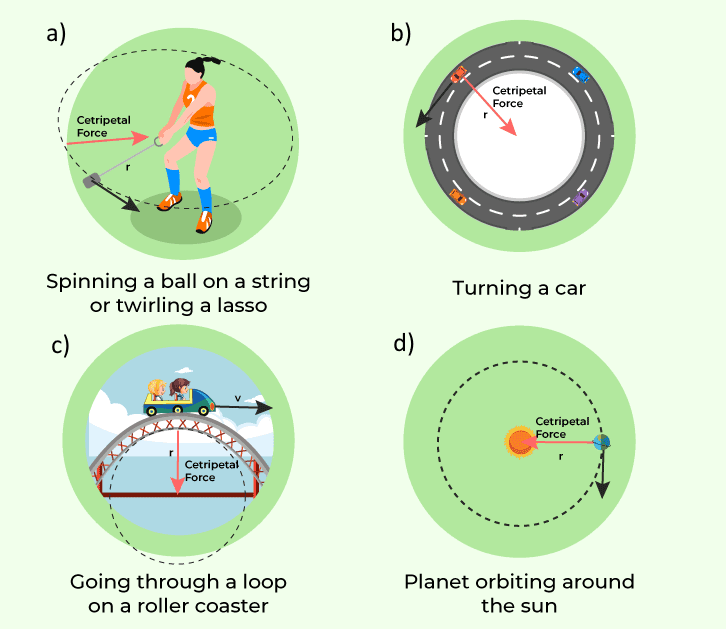Section 3: Uniform Ciruclar Motion
Section Learning Outcomes:
Section Key Terms:
Bored Already? Press the buttons to dive into applications!
Lesson 1: Introduction to Centripetal Motion
Angle of Rotation
is the circular motion of an object about an axis of rotation. We will discuss specifically circular motion and spin. is when an object moves in a circular path. Examples of circular motion include a race car speeding around a circular curve, a toy attached to a string swinging in a circle around your head, or the circular loop-the-loop on a roller coaster. is rotation about an axis that goes through the center of mass of the object, such as Earth rotating on its axis, a wheel turning on its axle, the spin of a tornado on its path of destruction, or a figure skater spinning during a performance at the Olympics. Sometimes, objects will be spinning while in circular motion, like the Earth spinning on its axis while revolving around the Sun, but we will focus on these two motions separately.
When solving problems involving rotational motion, we use variables that are similar to linear variables (distance, velocity, acceleration, and force) but take into account the curvature or rotation of the motion. We first define the , Δθ, which is the angular equivalence of distance. When objects rotate about some axis - for example, when Frisbee rotates about its center - each point in the object follows a circular path.

Figure 1: The angle of rotation (Δθ), arc length (Δs), and radius of curvature (r) shown on a Frisbee as it is spinning in the air.
The , Δs, is the distance traveled along a circular path. The , r, is the radius of the circular path. Both are shown in Figure 1.
Consider a line from the center of the Frisbee to its edge. In a given time, each point on this line moves through the same angle. The angle of rotation is the amount of rotation and is the angular analog of distance. The angle of rotation Δθ is the arc length divided by the radius of curvature:
The angle of rotation is often measured by using a unit called the radian (radians are actually dimensionless, because a radian is defined as the ratio of two distances, radius, and arc length). A revolution is one complete rotation, where every point on the circle returns to its original position. One revolution covers 2π radians (or 360 degrees), and therefore has an angle of rotation of 2π radians, and an arc length that is the same as the circumference of the circle. We can easily convert between radians, revolutions, and degrees using the relationship
Angular Velocity
If we want to determine how fast a Frisbee can rotate as it is thrown, the concept of angular velocity can be used to answer this question. First let's discuss angular speed before we delve into the concept of angular velocity. Angular speed, ω, is the rate at which the angle of rotation changes. In equation form, the angular speed is
If an object rotates through a greater angle of rotation in a given time, it has a greater angular speed. The units for angular speed are radians per second (rad/s).
Now let's consider the direction of the angular speed, which means we now must call it the angular velocity. The direction of the angular velocity is along the axis of rotation. For an object rotating clockwise, the angular velocity points away from you along the axis of rotation. For an object rotating counter clockwise, the angular velocity points toward you along the axis of rotation.
, ω, is the angular version of linear velocity. , v, is the instantaneous linear velocity of an object in rotational motion. To get the precise relationship angular velocity and tangential velocity, consider again a point on the rotating Frisbee. The point moves through an arc length (Δs) in a short time (Δt) so its tangential speed is
From the definition of the angle of rotation, we see that Δs=rΔθ. Substituting this into the expression for v gives
The equation v=rω says that the tangential speed v is proportional to the distance r from the center of rotation. Consequently, tangential speed is greater for a point on the outer edge of the Frisbee (with larger r) than for a point closer to the center of the Frisbee (with smaller r). This makes sense because a point farther out from the center has to cover a longer arc length in the same amount of time as a point closer to the center. Note that both points will still have the same angular speed, regardless of their distance from the center of rotation.
Now, lets consider another example: the tire of a moving car. The faster the tire spins, the faster the car moves - large ω means large v because v=rω. Similarly, a larger radius tire rotating at the same angular velocity, ω, will produce a greater linear (tangential) velocity, v, for the car. This is because a larger radius means a longer arc length must contact the road, so the car must move farther in the same amount of time.

Figure 2: A car driving with the angular velocity and tangential velocity of the front tire shown.
However, there are cases where linear velocity and tangential velocity are not equivalent, such as a car spinning its tires on ice. In this case, the linear velocity will be less than the tangential velocity. Due to the lack of friction under the tires of a car on ice, the arc length through which the tire treads move is greater than the linear distance through which the car moves. It’s similar to running on a treadmill or pedaling a stationary bike; you are literally going nowhere fast.
Centripetal Acceleration
The simplest case of circular is , where an object travel a circular path at a constant speed. Note that, unlike speed, the linear velocity of an object in circular motion is constantly changing because it is always changing direction. We know from kinematics that acceleration is a change in velocity, either in magnitude or in direction or both. Therefore, an object undergoing uniform circular motion is always accelerating even though the magnitude of its velocity is constant.
You experience this acceleration yourself every time you ride in a car while it turns a corner. If you hold the steering wheel steady during the turn and move at a constant speed, you are executing uniform circular motion. What you notice is a feeling of sliding (or being flung, depending on the speed) away from the center of the turn. This isn't an actual force that is acting on you — it only happens because your body wants to continue moving in a straight line (as per Newton's first law) whereas the car is turning off this straight-line path. Inside the car it appears as if you are forced away from the center of the turn. This fictitious force is known as the . The sharper the curve and the greater your speed, the more noticeable this effect becomes.
Figure 3 shows a car moving in a circular path at constant speed. The direction of the instantaneous tangential velocity is shown at two points along the path. Acceleration is in the direction of the change in velocity; in this case it points roughly toward the center of rotation, which is at the center of the circular path. If we imagine Δs becoming smaller and smaller, then the acceleration would point exactly toward the center of rotation, but this case is hard to draw. We call the acceleration of an object moving in uniform circular motion the , ac, because centripetal means center seeking.

Figure 3: Directions of the velocity of a car at two different points.
Now that we know that the direction of centripetal acceleration is toward the center of rotation, let's discuss the magnitude of centripetal acceleration. For an object travelling at speed v in a circular path with radius r, the magnitude of centripetal acceleration is
Centripetal acceleration is greater at high speeds and in sharp curves (smaller radius), as you may have noticed when driving a car, because the car actually pushes you toward the center of the turn. But it is a bit surprising that ac is proportional to the speed squared. This means, for example, that the acceleration is four times greater when you take a curve at 100 km/h than a 50 km/h.
We can also express ac in terms of the magnitude of angular velocity. Substituting v=rω into the equation above, we get:
Lesson 2: Analysing Force in Circular Motion
Centripetal Force
Because an object in uniform circular motion undergoes constant acceleration (by changing direction), we know from Newton’s second law of motion that there must be a constant net external force acting on the object.
Any force or combination of forces can cause a centripetal acceleration. Just a few examples are the tension in the rope on a tether ball, the force of Earth's gravity on the Moon, the friction between a road and the tires of a car as it goes around a curve, or the normal force of a roller coaster track on the cart during a loop-the-loop.
Any net force causing uniform circular motion is called a . The direction of a centripetal force is toward the center of rotation, the same as for centripetal acceleration. According to Newton's second law of motion, a net force causes the acceleration of mass according to Fnet=ma. For uniform circular motion, the acceleration is centripetal acceleration: a=ac. Therefore, the magnitude of centripetal force, Fc, is Fc=mac.

Figure 12: Four examples of centripetal force in action: (a) As the string with a ball at its end rotates, it experiences tension causing a centripetal force; (b) The frictional force required for the turning of the wheels of a car is provided by the centripetal force; (c) In a roller coaster, the force provided to balance the normal force is the force provided by the centripetal force; (d) Planets resolving around the Sun also experience centripetal force because of the gravitational force (Geeks for Geeks).
By using the two different forms of the equation for the magnitude of centripetal acceleration, ac=v2/r and ac=rω2, we get two expressions involving the magnitude of the centripetal force Fc. The first expression is in terms of tangential speed, the second is in terms of angular speed:
Both forms of the equation depend on mass, velocity, and the radius of the circular path. You may use whichever expression for centripetal force is more convenient. Newton's second law also states that the object will accelerate in the same direction as the net force. By definition, the centripetal force is directed towards the center of rotation, so the object will also accelerate towards the center. A straight line drawn from the circular path to the center of the circle will always be perpendicular to the tangential velocity. Note that, if you solve the first expression for r, you get
From this expression, we see that, for a given mass and velocity, a large centripetal force causes a small radius of curvature - that is, a tight curve, as seen in the graph in Figure 13.

Figure 13: Change in the radius of curvature with a change in the magntiude of the centripetal force.
Lesson 3: Rotating Frames of Reference
Rotating Frames of Reference
Imagine you're in a laboratory, observing a centrifuge in action. A centrifuge is a device used to separate substances based on their density by rapidly rotating them. It consists of a rotating platform where test tubes or samples are placed. In this scenario, the centrifuge provides an excellent example of a rotating frame of reference. The frame of reference attached to the rotating platform is non-inertial because it is accelerating due to the circular motion.

Figure 18: A centrifuge being loaded with blood samples to separate substances based on their density (Get Archive).
When the centrifuge spins, the samples inside experience a centrifugal force, which pushes them away from the center of rotation. However, from the frame of reference tied to the rotating platform, it appears as though a centrifugal force is acting on the samples. This apparent force is due to the acceleration of the rotating frame and is directed outward, away from the center of rotation. This centrifugal force helps separate the substances based on their density.
It's important to note that the centrifugal force is not a true force in the conventional sense. Instead, it is a result of observing the motion from a rotating frame of reference. In reality, the samples in the centrifuge are actually experiencing an inward centripetal force, which keeps them moving in a circular path.